On May 4th (an easy one to remember), Mark, Maya, and I crossed the border from Colombia into Ecuador; a non-event that took about two hours and was much more relaxed than any Central American crossing we remember from 2006. Our visa stamp allows us to stay for 90 days.

Northern Ecuador Sights
Tulcán
Our first stop – after shopping for groceries and being pleasantly surprised to see dumpsters everywhere – was the topiary garden of the Tulcán cemetery. That first day in Ecuador, we also managed to get a SIM card and buy data and non-sweet bread, before settling at a great little spot by a pond.
(As always, click on or hover over photos in galleries to read their captions.)
San Gabriel
Laguna El Salado
If you’ve been reading my previous blog posts, it won’t come as a surprise that Colombia wore us out. Despite being enamored by its cute towns, beautiful scenery, and extremely friendly (and curious) people, the country is still rough around the edges and quite busy and loud. So when we stumbled across our first free boondocking (wild camping) spot and discovered it was quiet and attractive, we stayed for almost a week, catching up on sleep, work, and walks with Maya.
El Centro
Coming from Colombia, which has heaps of colorful, historic pueblos (towns), we knew not to expect much architectural eye candy in Ecuador. The center of San Gabriel was alright – tiendas (stores) and panaderias (bakeries) abound – and we learned that prime street parking spots (marked with blue lines) come with a fee.
Cascada de Paluz
Some locals had told us about this off-the-beaten-track waterfall, so we decided to check it out. After following a potholed dirt road for fifteen minutes, we reached this well-maintained and pretty park. The waterfall was impressive and overlooked by elves!
Grutas de La Paz
Then, it was time for our first – and cheapest – termales (hot springs) at Grutas de La Paz. For $2 per person, we could soak in two pools, explore the cave-turned-chapel, and park overnight in the lot. We discovered that Ecuadorians are hospitable and friendly as well, when chatting to a local granddad.
Chachimbiro Termales
We left the Panamericana (PanAmerican Highway) on a detour to the hot springs of Chachimbiro, to date my favorite ones. They were a bit pricey at $7 per person, but with fifteen or so pools, the variety in size and temperature was substantial and we had each tub to ourselves. One was covered, ideal for when the rain started again. Plus, the sauna was open and usable as well.
Again, we were allowed to spend the night on the property without an extra fee. Other highlights were Maya’s first interaction with llamas and our first glimpse of Volcán Cayambe’s snowy peak.
Ibarra
The main reason our trio stopped in Ibarra, which has several developed campgrounds, was to check out potential places for Maya and me to stay when Mark left for two weeks in June. Our free iOverlander app pointed us to The Garden (where we spent one night) and Finca Sommerwind, where we chatted with owner Hans, bought a German bread, and wandered the grounds. I soon decided that this area is far too noisy, being across from a race track literally yards (meters) away.
It was ear-poppingly loud on that Friday afternoon and Saturday morning. No way I could cope – and work – here for 2+ weeks! Plus, the no-see-ums (gnats) at Sommerwind were insane. After being there for half an hour, my arms were sprinkled with itchy, red dots. I’d worn pants as I knew about this problem, but didn’t think my upper body would be affected.
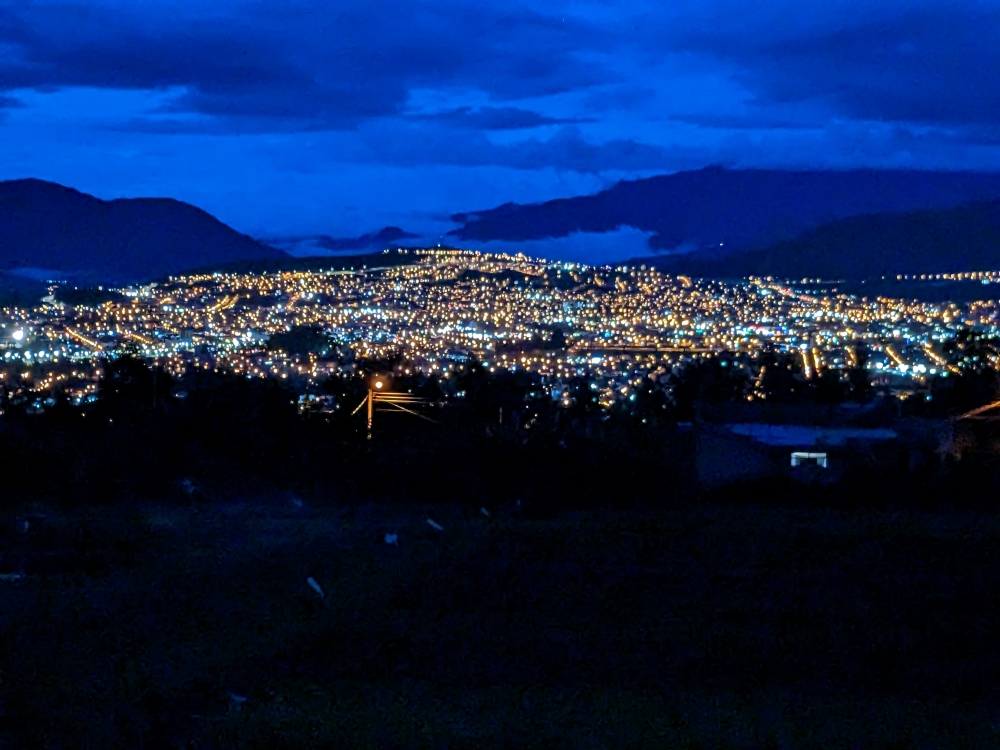
Ibarra at night, seen from Graham’s Place
Another location we were curious about was Graham’s Place, south of town. Australian Graham, local partner Amalia, and daughter Leah welcomed us to their beautiful property with nursery, two horses, and three dogs. We felt comfortable and happy here. The couple invited me back in June – and I accepted (after checking out a few more places near Quito). This is where Maya and I are currently camped.
Cotacatchi
To drive to our next destination in nature, we had to pass through the pueblo of Cotacatchi, so decided to have a quick look around. Surprised to hear English after being surrounded by a Spanish-speaking world for many months and to see a farmer’s market with gringos buying and selling wares, we Googled the village on a park bench.
Apparently, Cotacachi is one of the prime expat locations in Ecuador. We later ran into Hans (selling his German products at the gringo market as he calls it), who explained that the founder of the magazine International Living used to live here and therefore drew in the global crowds. He left to Vilcabamba and, supposedly, the same is now happening there. We will find out later.
Laguna de Cuicocha
From Cotacatchi, we drove to the Cuicocha crater lake. Dogs are not allowed in the (free) national park encompassing the lake and they are strict at the gate. Luckily, there was a nice wild camping spot nearby. We could walk to a viewpoint by a (closed) restaurant in half an hour and, on a clear morning, managed to spot towering Cayambe again. We looked forward to driving to its glacier.
Unfortunately, the following day was cold and rainy. Mark and I walked into the park without Maya. At this altitude and in this climate, I didn’t feel like hiking much, but Mark followed the strenuous 5-mile loop trail at a fast pace (three hours), because I needed the internet for a translation project with a tight deadline. He needed the phone – which has our data plan and hot spot – to prevent getting lost.
Otavalo
Cascada de Peguche
The indigenous town of Otavalo was next on the agenda. First, we visited the Peguche waterfalls (50 cents/person), another wonderful surprise of a park. The rain dampened the mood a bit, turning trails into mud, but we enjoyed our afternoon exploring the grounds. Maya was welcome to join us and (overnight) parking was possible for one dollar.
The market
The Otavalo market on Saturday is reported to be the biggest handicraft market in South America. Since we are not fans of crowded places, especially with Maya, we visited on a Sunday, which was quiet. After browsing the alpaca sweaters and blankets for over an hour, we only scored two sweaters for Mark. We couldn’t get a blanket for the price we had in mind (bargaining is expected here), so saved that for later.
Mark, Maya, and I finished our visit to town, as often, on the main plaza, people watching, listening to a live band, and eating a wonderful treat for $1. It’s easy to splurge at that price!
Lago San Pablo
We were on the lookout for another decent camping spot with cell service for a few days and San Pablo lake fit the bill. It was comfortable, quiet, and pretty enough, but some aspects were less than ideal. Tons of ugly concrete structures were abandoned, stray dogs were abundant, territorial, skinny, and not taken care of, and because of the frequent rain, the lake was about to overflow.
One local teenager told me about how the area had become very littered and how none of the (indigenous) communities cared about keeping la naturaleza (nature) clean. He lived a block away and as kids, he and his siblings and cousins would come to the lakefront, lie on their bellies in the grass, and drink the water. We stayed just long enough to get our online work done.
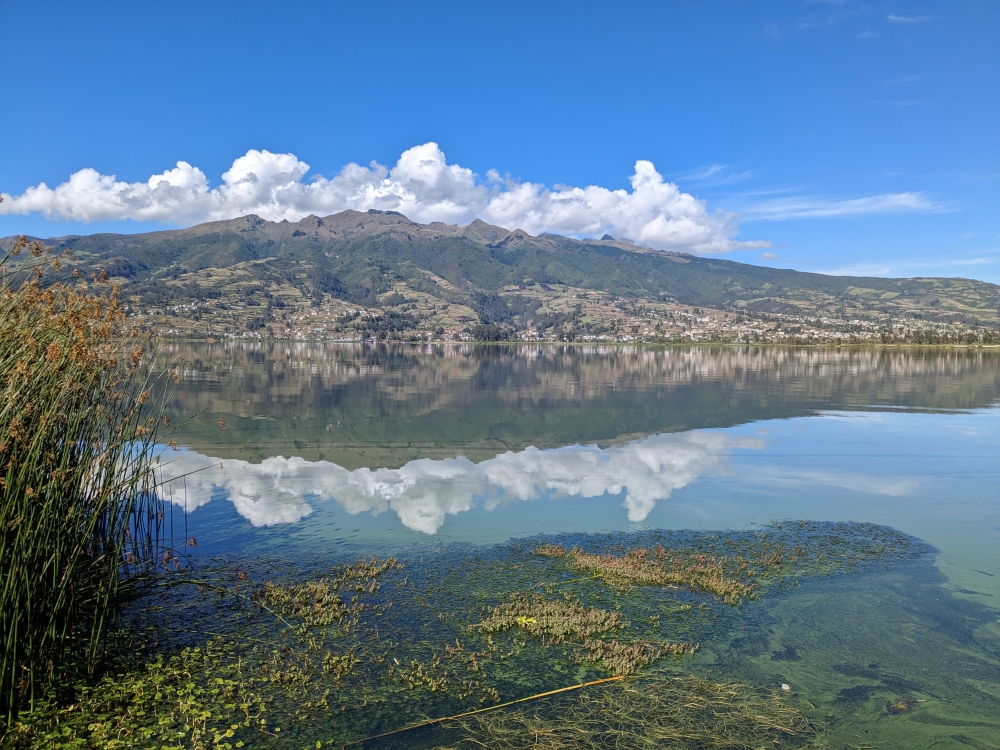
Lake reflection in the morning
Solar clock & Equator
Our drive to the snowline and glacier on the Cayambe volcano failed. An hour into the climbing, we were turned around at the national park entrance gate because of road work. We didn’t even get a glimpse of the majestic mountain.
After the descent, we continued to the solar clock and equator line in Quitsato. Entrance was $5 a person, which we found steep to join a short, guided tour and take photos at the equator line. And, yes, it was located exactly at 00° 00’ 00”!
They don’t allow campers to park in their lot overnight, so we moved to El Pisque hot springs close by to sleep. To our joy, it was located next to a rushing river (the perfect background noise to block out barking dogs and crowing roosters) in a scenic area. We never soaked in the pools ($2/p.p.), because they were too busy.
Oyacatchi
We skirted the city of Cayambe to follow a nasty, potholed, dirt track for an hour, before it turned into a stretch of decent graded road and ended in the most perfect blacktop you’ve ever seen. This route brought us to remote Oyacatchi, which was inaccessible ten years ago. Now, tourism is on the rise and concrete sidewalks and paved streets are being built.
This access road – and the one we were to follow the next day – is not on Google maps, so we took a leap of faith, after some research. Oyacatchi, another indigenous town, has its own, attractive hot springs, where Mark and I had a great time, feeling like kids on the slide! Entrance to the termales is $5 per person and parking another dollar.
Apparently, there is a nice trail to a waterfall as well, but at $2 per person, we didn’t feel it would be worth it. We don’t like paying to hike in nature. We did, however, buy a $5 permit to access the road in Cayambe-Coca National Park.
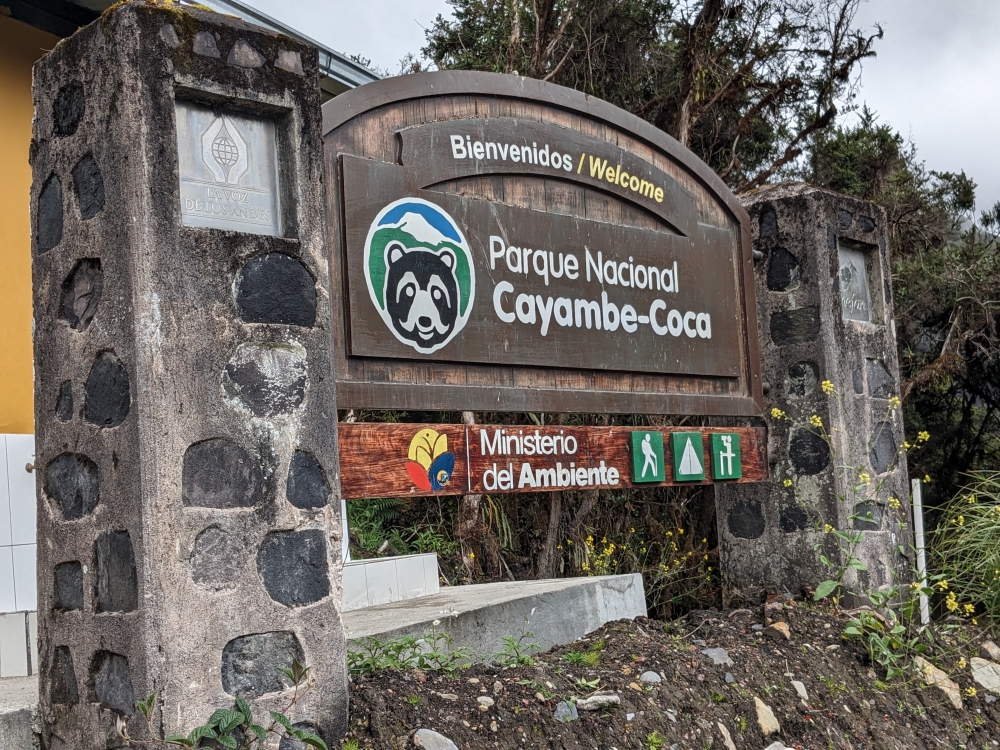
Cayambe-Coca National Park
This national park was worth the effort! Since the entire dirt road hovers around 12,000ft (3,660m) in altitude, the views were often obscured by clouds and fog. Yet, the scenery was striking. It took us about five leisurely hours to cover the 40km (30-mile) route, stopping for photos and a sandwich lunch and making the detour to a reservoir, which we learned provides the water supply for Quito.
We did not pass another car and contemplated spending the night. But, the chilly temperature and lack of cell service made us reconsider. At the southern end of the park, we hoped to sleep in the lot, but a grumpy NP employee told us he didn’t allow that. He also mentioned that nobody is allowed to drive into the park, especially with a dog and complained about the local people at the northern end letting visitors “buy” their way in…
To hike the trail to a waterfall and lake viewpoint in this section of the park, we had to leave Maya behind. Despite the altitude, we huffed it to these attractions at a fast pace and managed to find a pretty camping spot further down the mountain road. The following morning, however, we were chased off by a guy saying this was private property of the Papallacta Resort. No signs were present.
Peña Pivico
At this point, Mark and I were killing time for a highly-anticipated meet-up with friends in Quito the end of May. We moved to the Peña Pivico rock climbing site to spend a peaceful night in the presence of a rushing river and a herd of curious cows. They loved hanging around Thirsty Bella. More rain overnight turned our parking area into mud and created a waterfall rushing down the steep rock face. We left.
Jamanco Hot Springs
Termales Jamanco ($4/person) are located in the fancy resort area of Papallacta, but are its cheaper cousin. This was our last stop before finally, after four weeks in the country, reaching the capital Quito. We arrived at the springs on a Sunday afternoon and stared at the hectic, screaming scene in horror. No way we were going to mingle with the crowds in the pools. We learned that the piscinas would be cleaned overnight and decided to go for a soak the next morning, before leaving for another potential camping place for Maya and me.
It was cool to camp next to a river again and – surprisingly – to get company from other caravanners. The two couples were from Ecuador and invited us for a visit to their home base in Coca, in El Oriente, also called Amazonia. Time will tell if we decide to make the long haul there or not. When Mark returns, we will be over halfway on our visa allowance and need to figure out what to do about an extension. This process is inconvenient (because we have to deal with the TIP, Temporary Import Permit, of our car as well) and expensive (~ US$150/person). If only we could stay everywhere as long as we desired!
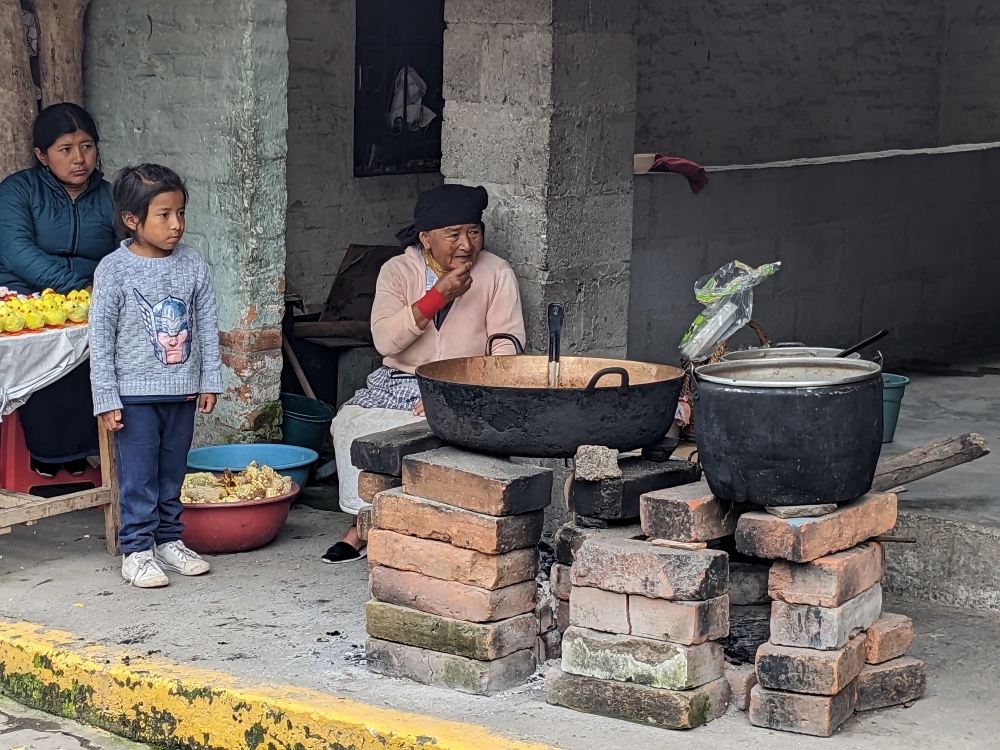
Selling locally cooked food
Curious about a previous ten-year chapter in our nomadic lives, which includes eight years aboard a 35-foot sailboat in the tropics with dogs, check out my compelling, inspiring, and refreshingly honest travel memoir:


















































































































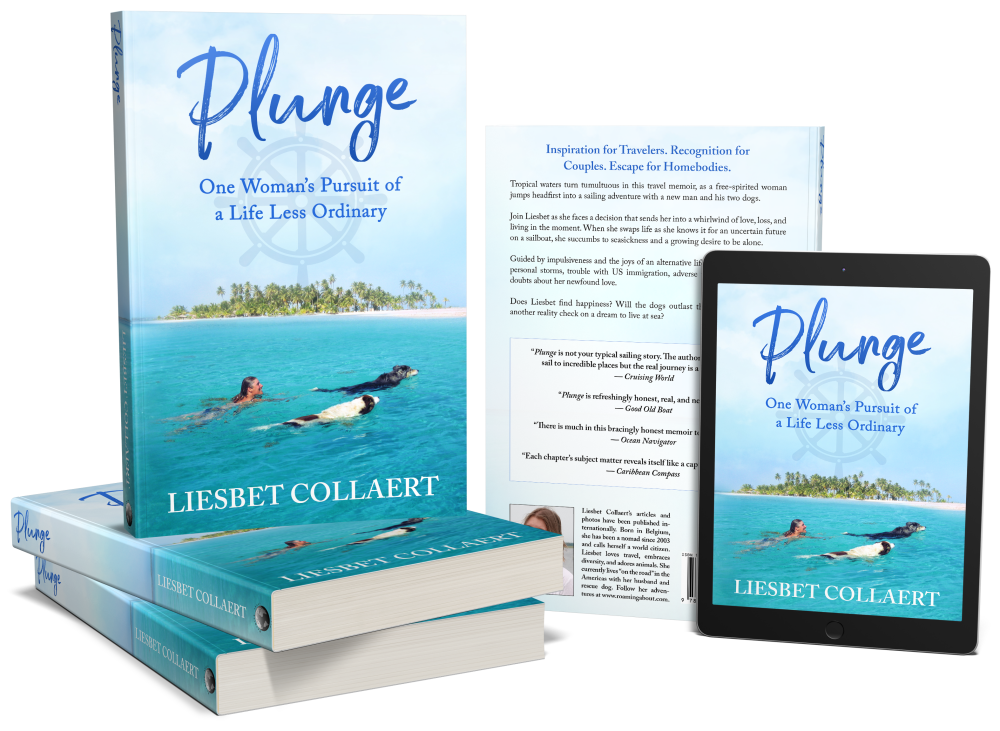




June 19, 2023 at 14:34
My first impressions of Ecuador are far more favorable than Colombia. Many happy new adventures to you, Mark, and Maya.
June 19, 2023 at 23:14
Thanks, Pete. We feel like Ecuador had been “easy,” so what’s not to like about that? 🙂 Seriously, it feels nice to “just” travel and camp and sit for a few days to work… And then soak for a couple of hours. We are finding a nice balance.
June 19, 2023 at 16:54
You three seem to be frolicking in Ecuador. Congratulations on reaching the Equator. Until now, I hadn’t seen the similarities between the two words!
June 19, 2023 at 23:15
Ha, Marian. Interesting discovery for you! There is a reason that Ecuador is called Ecuador. 🙂 Yes, we have been frolicking, taking our time to see some sights and do some work. Finding a decent balance.
June 19, 2023 at 17:12
I still have a tablecloth bought in the market at Otavalo in 1999!
June 19, 2023 at 23:17
Wow, Anabel! That’s amazing. Your Otavalo tablecloth must have been good quality!
June 19, 2023 at 17:23
Don’t worry about the blanket. I strongly suspect the “alpaca” blanket I got in Otovalo is acrylic despite the cost! What did you think about Cotacachi as a place to live longer term?
June 19, 2023 at 23:23
Hi Marie!
You might be right about the material of the blankets and sweaters. They do have certain designs and colors that are abundant. We did eventually buy our alpaca blanket (which we needed for our bed) at an artisanal market in Quito.
Mark and I were not impressed by Cotacatchi but there is a bakery with yummy pain-au-chocolats. 🙂 And the square is alright. But I honestly don’t see why Cotacatchi would be more attractive to live than, say, Otavalo. Maybe it’s more peaceful? The surroundings of both towns are pretty. We are curious to compare it to Cuenca, Loja, and Vilcabamba later this summer. Stay tuned!
June 19, 2023 at 19:44
Many Americans have found Ecuador to be a good place to retire because of its friendly population and low cost of living.
June 19, 2023 at 23:25
Yep! And the currency is the US dollar, so presumed to be quite stable. It all makes sense now that we have been here a while. I guess we’ve gotten over the initial shock – after Colombia – of the popularity of the country, its level of tourism, and the integration of English-speakers and expats.
June 19, 2023 at 20:52
Ecuador looks amazing! Gnats though….
June 19, 2023 at 23:26
Yep, gnats. Just like in Colombia. Although, the higher you camp, the less they’re around. 🙂 I can’t wait to relax on a grassy lawn one day without getting bitten!
June 19, 2023 at 21:02
A lot to love about this leg of the trip–four old men chatting in the park, the cow in the road, Maya splashing around. So much fun, Liesbet.
June 19, 2023 at 23:28
Hi Jacqui,
I’m glad I can entertain you with my photos and life snippets. Yes, there has been happiness in Ecuador. Of cows, dogs, llamas, and humans. And lots of authenticity as well. Now the question is: how long do we want/need to stay?
June 20, 2023 at 16:16
Hi, Liesbet – I know very little about travel in Ecuador so greatly look forward to continuing to follow your adventures. So far, Equador is sounding like much easier travel that I had anticipated.
June 21, 2023 at 10:56
Hi Donna,
I hope you learn a bit more about Ecuador and its sites as I document them on Roaming About. It is a small country compared to others in South America, but we are finding plenty to see and do and are now thinking that visiting for three months might not be enough. And, yes, traveling – and finding free campsites in nature – has been easier than in Colombia. For that, we are grateful! 🙂
June 20, 2023 at 16:48
This leg of your trip sounds much more relaxing! I drew a breath of relief on your behalf. And I’m still amazed at how well you’re managing at such high altitudes. Do you feel as though you’ve acclimatized to the altitude, or are you still being cautious?
June 21, 2023 at 11:02
Hi Diane,
So far, so good in Ecuador. The ease of travel and driving was hard to believe at first, as we kept holding our breath for a while. Now, we are more relaxing about our trip, but we still have to be cautious as some areas are reported to be unsafe, like Guayaquil and certain coastal towns. We met people who have been robbed and some expats mentioned things are getting worse in this country. Apparently, Ecuador used to be one of the safest countries in South America and that’s why it grew in popularity. We will see…
Regarding the altitude, yes, it is possible to somewhat acclimatize, especially if you take it easy. We found that living around 10,000ft is doable and traveling higher up as well, if we sleep at a lower elevation. We have gotten pretty used to 8,000ft for living and exercising (walking/hiking). Hiking at elevations higher than that is cumbersome and we still need to take it slow!
Of course, once we get lower again, like the town of Mindo, which we visited already, or the coast, which we plan to visit, we will have to build up that tolerance and acclimatization again afterwards.
June 20, 2023 at 22:01
Wow – that’s a ton of places you’ve already been! I thought Ecuador was very pretty (even though it rained the entire time I was there), and it looks like all of your stops have been nice as well. Did you know there are three equator monuments?! I don’t even remember which one we chose to go to (I think we were trying to find the most authentic one), but from what I can tell, we went to a different place than you did. (Not to say we found the “real” one – who knows?) I was also surprised to see the crater lake in your photos; I was silly enough to think Quilotoa was the only one! Hope you continue to enjoy the country!
June 21, 2023 at 11:09
Hi Lexie,
We are entering the dry season now (summer or verano) in Ecuador, so it is nice to finally see the sun again – and blue sky!!! – after six months of rain and clouds. This means that it is getting quite hot. We are at 8,000ft, but being this close to the equator and the sun means that she is blasting!
The most famous, touristy, and popular equator monument is called Mitad del Mundo (Middle of the World) monument, which has an entire amusement park built around it and which is actually NOT on the equator. It’s kind of a tourist trap. We did not visit but drove by.
Then, there is the monument (solar clock and museum) that we visited, which is ON the equator. We checked. 🙂
And there is a small plaque in the town of Calacali, which we recently stopped at. A line is painted on the actual equator (we checked the gps here as well) and there is not much fuss. It’s on a quiet town square. I’ll post photos of both other places in the future.
June 21, 2023 at 11:24
Forgot to mention that we have three crater lakes on our “wish” list in Ecuador. The one we visited already, Cuicocha, the one you mention, Quilotoa, and Laguna de Mojanda, which is off the beaten track, one way in and out and reportedly not the safest, so we didn’t wanted to risk it. So far. We have another chance at getting to Mojanda when Mark comes back, as we moved north again for my current stay in Ibarra.
June 21, 2023 at 00:48
SO impressed you were able to include photos and ‘snippets of life’ from a month’s journey southbound through Ecuador. You must be both speaking fluent Spanish by now. Curious what your impressions will be when you visit some more towns we spent time in like Cuenca and Guayaquil. Hope you’ve been safe as we had a tough time in Quito but great memories nonetheless.
June 21, 2023 at 11:16
Hi Annie,
I WISH we were both fluent in Spanish, but I fear this only happens when one actually lives in the same country for a few years. At least, I hope so.
Mark gets by and I’m doing quite well, but it’s interesting 1) how the language and terms differ between countries (yes, there are even substantial differences between the Spanish in Colombia and Ecuador and initially I had a harder time understanding the language here as well), and 2) how my vocabulary often lacks, despite doing so well with the DuoLingo app!
In general, I do find it easier to speak (since everything is in my control) than to listen and understand. I recently had an hour-long conversation with a local friend here in Ecuador, telling her the entire story about how Mark and I met (basically a chapter in my book) and managed. I was proud of that! 🙂
Guayaquil (and some parts along the coast) are off limits right now. They are too dangerous. Everyone – from locals to tourists to expats – have warned us to skip Guayaquil and we will. We are looking forward to Cuenca, but often, the higher the hype about a place, the less impressed we are when visiting, so we will see.
June 21, 2023 at 03:39
Thanks for giving us a glimpse of your marvelous life! Oh, to go places like you do.
June 21, 2023 at 11:17
Hi Lux,
Thanks for swinging by and leaving a comment. It’s not that special what we do – it’s a choice of a lifestyle. I hope you get to go to some interesting places as well. The world is the biggest and most interesting school! 🙂
June 21, 2023 at 04:43
Fabulous, Liesbet. I visited Ecuador in 1996 for an exploratory white water rafting trip. Most of the time I had no idea where I was – we were in the middle of nowhere bagging first descents, although I do know I visited Otovalo!
It’s lovely to revisit this wonderful country in pictures!
June 21, 2023 at 11:20
Hi Jackie,
How cool you got to explore some of the wild rivers in Ecuador way back when! I’m sure they are all well used now by rafting companies and by tourists from around the world! Otavalo is an interesting city that has a lot to offer – culturally, artisanally, and scenicly. 🙂
Thanks for coming along for the virtual and visual ride!
June 22, 2023 at 11:16
I can literally feel your more relaxed conversation with us, Liesbet, now that you are in Ecuador. Rough around the edges definitely still personifies Colombia. Glad you found a quiet place to work and relax while Mark was gone. Gorgeous areas you’ve explored and I’m sure more to come. Enjoy!
June 23, 2023 at 11:41
Hi Terri,
Thanks for following along on our Ecuador journey as well. Yes, life and traveling has been a bit more relaxing and peaceful here. We are able to stay longer amounts of time in places and that, in turn, allows us to focus on our work schedules better. Less stress and rush that way!
June 22, 2023 at 18:08
Liesbet, I’m glad you’re able to relax more in Ecuador. I enjoyed reading your post. It brought back fond memories of Ecuador for me. I also visited the Equator (the touristy and non-touristy sites), Papallacta hot springs, Peguche waterfalls and Otavalo. Safe travels!
June 23, 2023 at 11:44
Hi Natalie,
Every time I check out hot springs now, I think about you, because you made a remark about the abundance of them in Ecuador, while we were still in Colombia. It sounds like you visited the northern part of Ecuador? Or are you referring to the places we have been so far? Maybe you ventured to the south of the country as well? The Papallacta hot springs seem to be the cream of the cream – and refreshingly clear as well. If we felt like spending more money, I’d like to check them out. But at $9 per person, the cost adds up.
June 23, 2023 at 10:35
Ecuador already (from this post) sounds like a more favourable place than Colombia. Just seeing those plant statues would have got my attention. Am I right in thinking it doesn’t seem as chaotic as Columbia?
Glad you found a safe and happy place for your two weeks without Mark. It looks such a beautiful place where you were staying.
I’ve stood aside both sides of the Greenwich Mean line, but standing on both sides of the Equator is up there with standing on both sides of the International date line. Something I hope to do, one day).
Thanks for sharing all the wonderful pictures of your trip. It makes all the difference seeing as well as reading about your adventures.
June 23, 2023 at 11:51
Hi Hugh,
You are right! Ecuador doesn’t come close to the chaos and hecticness of Colombia! We are enjoying the more peaceful pace and surroundings, for sure. Yet, neither of us can say we like Ecuador better than Colombia. Yet. 🙂
My current camping spot on the driveway of friends is pretty and comfortable, but I wish I could say it’s quiet as well. Therefore, we have to return to nature. Soon. Mark will be back next week and after fixing a few things on the truck, we will be on our way again.
I hope you’ll be able to straddle the International Date Line one day, Hugh. If there is actually such a thing painted on the ground, like the equator line. I remember crossing the equator in Sumatra, Indonesia, more than two decades ago but I don’t remember an actual line. If you could go there for the experience, it’s not that much further to the IDL. 🙂
June 26, 2023 at 06:59
Such beautiful scenery and I love those hedges!
June 26, 2023 at 10:28
Thank you! Ecuador has been quite pretty, leading up to more spectacular scenery in Peru and beyond! 🙂
June 29, 2023 at 15:38
Its a great country and you are seeing places we would love to visit ourselves.
June 29, 2023 at 21:20
Hi Susan,
There sure is a lot to see and do in Ecuador and we like the fact that it is a relatively small country. That being said, our slow travel might bite us in the butt if we only stay three months! We are starting to run out of time and haven’t gotten further south than Quito! 🙂
June 29, 2023 at 19:34
I hope you enjoyed your break! And I hope you can swing an extension in Ecuador – or perhaps swing back next year when we are there!
I love Mark’s new sweater. And the topiaries, and waterfalls, and views, and the llama, and the solar clock!
We have to visit the solar clock. I’m super curious about this east at the top map.
And the slide pic. Reminds me of the rock slide Baja Sur!
June 29, 2023 at 21:40
Hi Duwan,
Quito was definitely a fun mini-break. We are finding enough to see and do to warrant an extension, but it will put a serious dent in our expenses if we decide to extend. I’m not sure what we will do.
Mark has now returned and after we deal with a couple of car-related repairs, we will only have a month left to explore the bigger part of this country…
I think you and Greg will enjoy your time here. The tourist sites are pretty straightforward and Ecuadorians are used to gringos. You’ll have a lot of chances to practice your Spanish!
Why do I not remember the “rock slide” in Baja Sur??